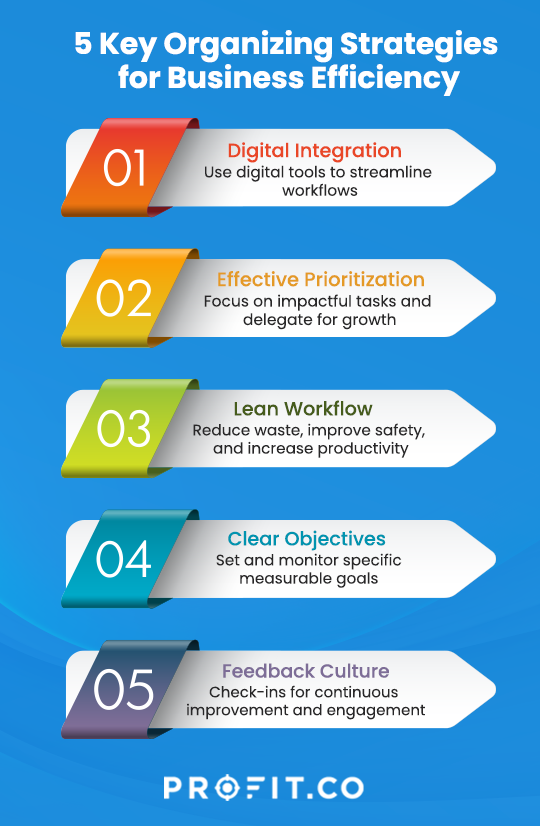The Power of Organizing Your Workflow
Organizing your workflow is not just about tidying up processes; it’s about crafting the pulse of your company’s daily operations. It’s a strategic activity that shapes your organizational culture, sets a benchmark for excellence, and dictates the rhythm at which your team operates. That is why it is important to take the time to create something unique to your business rather than following what is recommended for all businesses. Create a workflow system tailored to your business’s unique needs and aspirations. This isn’t about unquestioningly adopting generic best practices; it’s about innovatively crafting a system that resonates with the specificities of your venture. Today’s choices in organizing your workflow are more than just procedural adjustments; they are investments in efficiency, time management, and financial prudence. In the following sections, we’ll list some organizational strategies suitable for the forward-thinking entrepreneur. These transformative practices can redefine how you and your team achieve success.The Art of Being Organized
The Art of Being Organized in Business often seems more daunting than it is. In many cases, the seeds of organization are sown during the very inception of your business, driven by the unique product or service you offer. This fundamental aspect defines all subsequent activities and operations. The key lies in effectively communicating your vision and objectives to your employees, ensuring that every action they take aligns with and furthers your overarching business goals. Say you run a home renovation business. A lot of your work will depend on positive communication with your clients, who, in turn, will recommend you to others. You are about to send one of your employees to meet a customer. She asks you what to do, and you say, “Just do a good job.” Albeit a positive comment, it does not define how you expect her to work with the client. She completes the work, but you notice that the clients do not seem to be glowing with appreciation. You talk to her and find out she focused on simply meeting regulations so they couldn’t complain about quality. Good work, certainly, but not what you wanted. Next time, you outline the values you expect the work to reflect. You say, “Make it personal, tasteful, and affordable.” In a larger context, you explain the necessity beyond good quality and the need to work closely with the clients. You then take this idea and make it a company standard so that all employees understand and can teach new ones as well. As you do that, workflows will become more efficient, and you become more hands-off. Remember, it’s not about getting everything perfect from the start; it’s about being aware, adaptable, and willing to refine your strategies as you grow.To learn more about how HR tools can improve your workflows
Getting Started with Organization
Before diving into the details, laying a strong foundation for your organizational strategy is essential. Consider these key points as your starting blocks for building a well-structured and efficient business:- Clarify your business’s vision and purpose.
- Establish specific and measurable objectives.
- Focus on creating efficient and simple workflows.
- Foster a work environment that values clarity and purpose.
- Lead by example in organizational efforts.
- Plan with future growth and scalability in mind.
Clear Workflows for Consistency
In pursuing a focused, efficient, and rejuvenating work environment, it’s not just about the office’s physical layout but also about the structure and flow of work. Creating distinct workspaces tailored to the specific needs of different tasks can significantly enhance productivity. For instance, roles that demand creative thinking might benefit from a more relaxed, open space, encouraging brainstorming and innovation. Conversely, positions requiring uninterrupted concentration would thrive in a quieter, more isolated setting. Regardless, it’s important to keep your employees’ needs in mind. With that said, your work environment can mean more than just the physical space. Much of today’s work is done digitally and the same principles apply there. Create different spaces for different functions. Take a finance company as an example: the nature of the work involves collecting, processing, and presenting data. By establishing clear digital workflows and creating templates for different functions, you can streamline processes, making them more efficient. This approach not only organizes the work but also respects the cognitive load of your employees. It’s about providing them with the necessary information in a structured manner, eliminating clutter, and enhancing focus. The better you understand and cater to the thought processes of your employees, the more effective these systems will be. This holistic approach to physical and digital workspace organization ensures a consistently productive and employee-friendly environment.Out of clutter,find simplicity
Work Management Tools for Automation Success
Embracing automation is key to scaling your business in today’s fast-paced environment. With an enormous range of applications and tools available, identifying areas in your business process that are ripe for automation can bring significant efficiencies. The first step is to analyze your workflows meticulously. Where are the stopgaps in it? What tasks seem excessively repetitive and do not require much human intervention? Questions like these are only the first step but can be very impactful in making your employees’ lives easier and saving time. This initial assessment is crucial and can substantially improve efficiency and employee satisfaction. Consider the example of HR software. Human resource management becomes increasingly complex as your company grows, but thankfully, this is a common challenge many businesses face. As a result, numerous HR tools are available that, once customized to your specific requirements, can automate many time-consuming HR tasks. Implementing such software can dramatically streamline your HR processes, saving weeks or even months of manual effort over time. Similarly, evaluating other aspects of your business operations can reveal opportunities for automation. This could involve customer relationship management, inventory tracking, or even financial reporting. By harnessing the right tools and tailoring them to fit your unique business needs, you can not only save time and reduce costs but also free up your team to focus on more strategic, value-adding activities. It’s a shift towards smarter work management where technology plays a pivotal role in driving business efficiency and growth.Five Key Strategies for Organizing Your Business Operations





